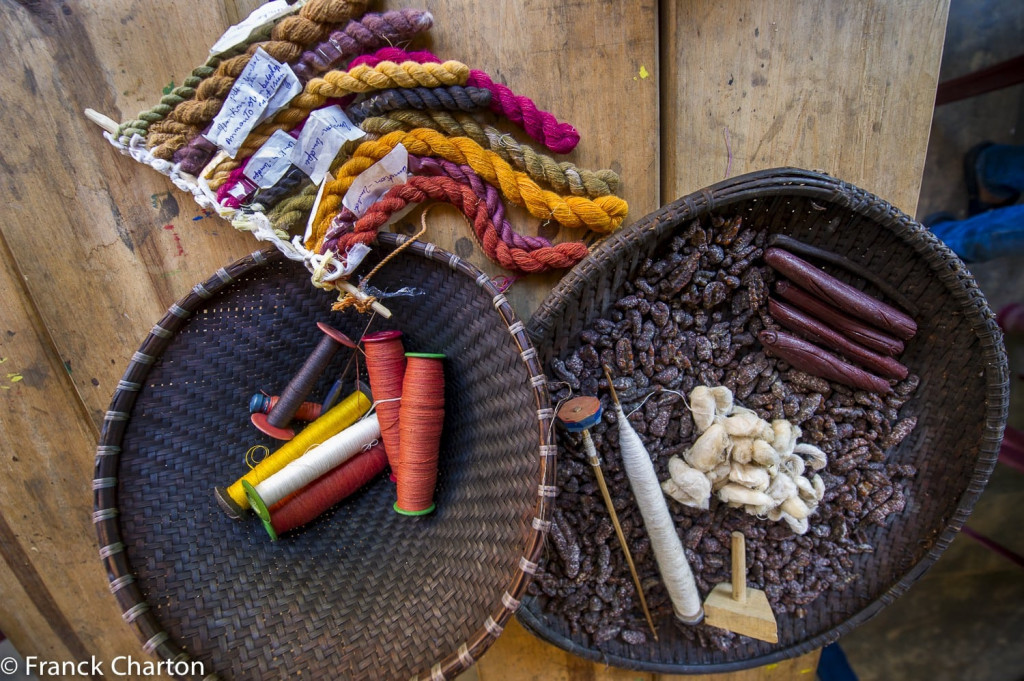
Assam is a confluence of a number of tribes and cultures and this is reflected in its traditional handicrafts as well. Even till date, the artisans maintain age old traditional style and methods of production.
Assam first came to recognition by the virtue of its exemplary silk, cane and bamboo products which are still believed to be its best offering. Over time many more interesting handicraft forms have emerged; like metal crafts, pottery, jewellery, paintings and woodcrafts.
There is a sense of simplicity and style in the skills of the Assamese craftsman which makes their products very unique and charming. You are sure to take back home some stunning souvenirs from your trip.
Handlooms
Handloom weaving is one of the oldest industries in Assam and is well known for its rich textures and designs, making it very special and exclusively unique about this state. Each ethnic group has its own distinctive design and style.
Traditionally every handloom fabric created was unique because the colours and designs varied from weaver to weaver. But in recent times, with designers taking an interest in rural craft, modern patterns and designs have been incorporated based on market trends.
The Regional Design Centre at Guwahati continues to guide and help indigenous handloom societies in the state to widen their market and increase sales. The raw materials mainly used are cotton, the world famous muga or golden silk, pat the white or “mulberry” silk and the warm eri or endi.
Often referred to as the “Manchester of the East” Sualkuchi, situated on the north bank of the Brahmaputra about 35 km from Guwahati, is the textile centre of Assam and renowned for its quality of muga, pat and eri silks. There are more than 3,000 weavers in and around this township.
Laichangphi, in the district of Cachar, is famous for its warm and soft quilts and the Mising tribe is renowned for their Mirizen shawls and blankets that can be used as bed spreads or even wall hangings.
Muga Silk
Muga silk (Muga Paat) or the golden silk is not only a nature’s gift to Assam, but also a symbol of rich Assamese culture. Also known as the “king of silks”, its name is derived from Assamese word ‘Muga’, which means yellow.
Owing to the low porosity of the muga yarn, it cannot be bleached or dyed so its natural golden colour is retained, which is the most significant characteristic of Muga silk. It is to be only hand washed increasing its lustre with every wash.
The fabric is superior in every aspect in comparison to the normal white silk that available all over the world. It is also much more durable. The traditional ensemble for women, called mekhela chador is made from this silk.
Pat Silk
It is also called Mulberry Silk as the silkworms live and feed exclusively on the leaves of mulberry plants. It is usually brilliant white or shiny silver in colour. Due to its refined sheen and texture, it is in great demand in fashion industries across the world.
Eri Silk
The word Eri (also known as Endi or Errandi) is derived from erranda, the Assamese word for castor and is made from worms that feed on the leaves of the castor oil plant.
Eri is also known as the Peace Silk as no silkworm is killed in the silk extraction process from cocoons. The cocoons are open-ended, allowing the moth to fly, leaving the empty cocoons to be hand-spun into yarn.
It is only produced in Assam, the east Khasi Hills and some parts of Arunachal Pradesh. A unique feature of this silk is that the products made from it are rather course when newly made but it gets softer and better with each use. It comes in a variety of colours, especially cream, gold, brown and beige.
Eri silk is very durable and its fabric is often passed down from one generation to another.
The gamocha
The Gamocha (Gamosa/ Gamusa) is a unique identity of Assamese Society. It is a white rectangular piece of hand-woven cotton cloth usually with a red border on three sides and red woven motifs. This small piece of cloth has high esteem and wide usage in Assamese culture and forms an integral part of almost all socio-religious ceremonies.
A Bihu dancer wraps it around the head in a knot; it is hung around the neck and used to cover the altar or holy scriptures at the naamghar (prayer hall) and to honour guests on special occassions as a token of respect. It has multiple usages and is usually seen used as a waistcloth, loincloth and towel.
Cane & Bamboo
Being rich in bamboo and cane reserves, Assam produces some very useful and daily utilities like baskets, hats, sieve, mats, stools and other useful furnishing out of bamboo and cane. Bamboo in particular is an integral part of architecture and infrastructure design in the villages.
An important and significant article made from strips of bamboo and dried palm leaves is the ‘Japi’, a traditional wide brimmed Assamese hat. It is used by outdoor workers for protection from the sun. They are also used as a representation of Assamese craft and seen in many households as a decorative item. It has also become a very popular souvenir for tourists.
Bell Metal
Metal craft comprises of one of the oldest cottage industries of Assam. In the Hajo region of Kamrup district, close to Guwahati and the Sarthebari region in the same district is famous for its bell-metal products like kalah (water pot) and tal (cymbals) with practically the entire population engaged in their production. Bell-metal items are also produced in Titabor, Jorhat district and Raha in the district of Nagaon.
A traditional Assamese dinner is served on kahi (plates) and bati (bowls) made of bell metal and food kept in containers made from this material stays fresh for a long time. Xorai, a bell-metal offering tray fashioned on a stand with or without a cover, has become the traditional symbol of Assam and is used to offer paan (stuffed betel leaves) to visitors.
These utensils make attractive souvenirs for visitors and in a bid to accommodate their products in modern contemporary homes; artisans are constantly innovating new product ideas.
Woodcraft
The woodwork industry in Assam was productive in ancient times when the forests were abundant with rare and valuable woods. It was traditionally carried out by a group of people locally named khonikors who hand carved wooden structures and decorations in the palaces of the Ahom rulers. It is reported that their work was so highly regarded that the royals built them a separate village called Khonikargaon near Sibsagar. Testimony to the artistic creations of the khonikors is evident in many temples and sattras (Vaishnava monasteries) in Assam.
In the plains of Assam the traditional carpenters, locally called Sutradhar form an important part of the village society. They traditionally earn their living by building houses, manufacturing carts, ploughs, looms, furniture, and boats and doing wood repair work. They are particularly known for decorating their looms and boats with intricate carvings of animal and floral motifs.
Assam still continues to have a thriving woodcraft industry although boatbuilding has declined over recent years. Carpenters now tend to focus on making household furniture while in the tribal villages’ artisans still use their traditional tools for building houses and household items and utensils.
Pottery
Assam has essentially two traditional potter communities- the Kumars and the Hiras, whose roots can be traced back many centuries. The process followed by the Kumars has remained the same since ancient times. They dig clay which they then beat and knead with their hands, feet or mallets of stone or wood and use a potter’s wheel to fashion different utensils which are then fired in a kiln. For a finishing touch, some untensils are hand painted with traditional motifs.
Hira potters are distributed in the Soalpara, Kamrup and Barpeta districts of the lower Brahmaputra valley of Assam. They follow a centuries-old traditional method of moulding clay shapes with their hands. After letting them partially dry in the sun they beat the clay into final objects before firing them in the kiln and colouring them. The men perform the hard labour of collecting the clay and fuel, they build kilns and transport and sell the finished articles to the bazaars.
In Majuli, pottery is made from beaten clay and burnt in driftwood fired kilns exactly as it was done during the ancient Harrappan civilisation over 4,000 years ago. The most commonly made pottery products are household articles such as pots, pitchers, plates, incense-stick holders, and earthern lamps as well as some modern design ornaments.
Masks
Bordhuvan village in the Nagaon district of Assam is the birthplace of the craft of mask making, locally known as Mukha. Here masks have a religious and spiritual significance. Upholding the religious significance of these masks, the craftsmen observe certain rules to ensure that the sanctity of performing the art has the exact sanctity of performing a prayer.
They are made from a variety of natural materials, ranging from terracotta and bamboo to wood, pith and metals. Besides cowdung, cloth, mud, jute, coconut sap and aatha (natural gum) are essential constituent of the craft. Organic colors that are used are Khorimati (white), hengul (red), charcoal (black) and haital (yellow).
The craft is a seasonal one and is usually started in winter (early November) in the hallowed premises of Vaishnav monasteries. The skill of mask- making is traditionally passed down from one generation to the next or in the sattras (Vaishnava monasteries) under the guidance of a teacher. It normally takes between ten to fifteen days to make a mask.
This industry has grown over recent years as more and more people buy masks as art forms to decorate their homes. Masks are also gaining popularity amongsts the tourists.
Toys
Toys speak a lot about the culture and tradition of a place. So much can be known about the heritage and customs of a given place through toys that mentioning them becomes inevitable when one speaks about the art and craft of a particular region.
Based on the raw materials used, Assamese Toys can be classified into four types – clay toys, pith toys, wooden toys, and cloth or cloth-mud toys. Clay toys are mainly made in the Goalpara region of Assam and have the characteristic pinched facial rendering of the mother and the child. Besides these, figures of gods, goddesses, and animals are also made by the traditional toy makers. The traditional clay toys in Assam are made by the potters of Hira and Kumar communities.
Most of these toys are in the figures of dolls, depicting brides and grooms. Goalpara region is also famous for the cork or pith toys. In this case, mostly figures of birds dominate the overall output, but animal figures and forms of gods and goddesses are used as well.
Other materials used are wood and bamboo. Toys made of cloth, or a mixture of cloth and mud, have also become a part of the Assamese toy making culture. Toys are important for the cultural growth of a region. They are like torches that guide children into adult life and into the myths and mysteries of their culture. The toy craft of Assam keeps that tradition alive.
Jewellery
Assam’s rich tradition of manufacturing gold jewellery dates back to several centuries. It has a rich collection of exquisite traditional jewelry mostly depicting floral and fauna treasures of the region which is unique and exclusive to the state. Jorhat, the second biggest city of Assam, is the main jewelry making centre of the state.
Traditional designs of Assamese jeweleries are simple but decorated with vibrant red gemstone, ruby or mina. Black, red and green colors on gold jewelries are most favorites among the buyers; these colors also dominate the traditional dresses of tribes and communities of the northeastern states.
The most famous ornaments of Assam are those made of gold. A special tribe of people called Sonowal Kacharis were particularly involved in gold washing the various rivers. Apart from gold, other metals like silver are also used in the conventional jewelry making.
Schools of Painting
The paintings of Assam can be categorised into three main schools.
Tai-Ahom School
The earliest existing examples of manuscripts illustrated in Assam represent the Tai-Ahom School and are from the Phung Chin manuscript dated 1437 AD, which contains illustrations depicting the mythological sixteen heavens and sixteen hells. Since Assam has a well-established artistic tradition in other art forms, it is thought that the art of painting existed much before this, but due to humid and adverse climatic conditions of the region, earlier works may not have survived.
Sattriya School
The Sattriya School of painting was developed by Sankaradeva, the 16th century spiritual leader of Assam. The earliest existing example is the 17th century manuscript the Chitra-bhagavata originally called the Adi-dasama, the text of which was translated into Assamese by Sankaradeva and recovered from a sattra in the district of Nagaon. Characteristics of the Sattriya School include nude male figures, the similiarity of male and female forms which may only be distinguishable by attire, large and wide fish-type eyes, ponds filled with lotus flowers, waterfowl and vermillion backgrounds.
Ahom or Court School
The Ahom or Court school emerged under the patronage of King Rudrasimha and the reign of King Sivasimha in the 1700s as a fusion of the Sattriya school and imported Muslim styles. Manuscripts that survive from that period include the Sankhasur-badha (1726) and the Dharma-purana (1735).
Discover North East India Handicrafts

Feel free to contact us if you are specific about which Arts & Crafts you would like to discover or would like to know more about them. Kriya, our professional material designer, will be eager to create a unique itinerary for you.



